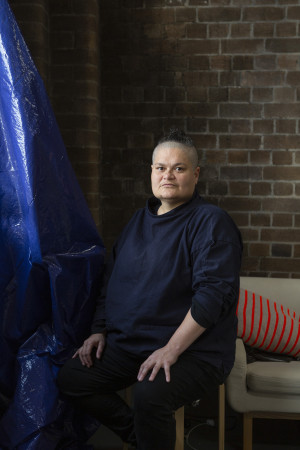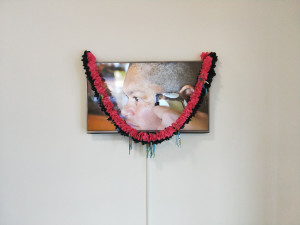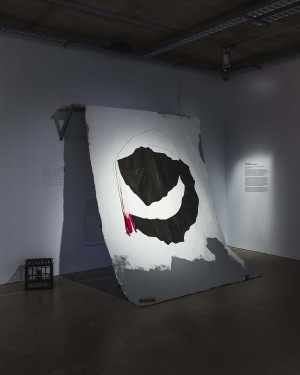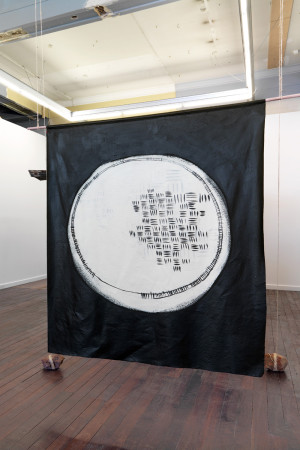Artist
Salote Tawale

Salote Tawale was born in Suva, Fiji Islands and grew up in the South Eastern suburbs of Melbourne, Australia. Cultural identity is a central focus in her research. The inherent conflict of being from a mixed heritage (Fiji and Australia), that simultaneously includes and excludes Tawale from a dominant post-colonial Australia, is a significant consideration in her arts practice. Intrinsically performative – employing photography, video, drawing, sculpture, installation and live actions – Tawale re-forms and performs her identity and experience of a translocated Indigeneity, that is, removed from land and separated from traditional practices and consequently repositioned within immigrant histories.
Tawale completed an undergraduate degree in Media Arts at RMIT University and a Masters of Fine Art at Sydney College of the Arts. Her works have been exhibited within Australia and internationally including at ParaSite Gallery, Hong Kong; St Pauls Gallery, Auckland; Indonesian Contemporary Art Network Yogyakarta; and Campbelltown Art Centre, Sydney. In 2017 Tawale was awarded the inaugural Arts NSW Visual Artists Fellowship to record oral histories and connect to artists in the Fiji Islands, travel to major art events in Europe, including the Venice Biennale and Documenta, and forge connections with the Institute of International Visual Arts and Stuart Hall Library in the UK. Tawale is the current recipient of a six-month Australia Council for the Arts residency hosted by ACME studios in London.
In Conversation
Salote Tawale in conversation with Artspace Executive Director Alexie Glass-Kantor
Alexie Glass-Kantor (AGK): Can you just briefly describe for us your practice and background as an artist?
Salote Tawale (ST): I started off as a photographer, a landscape photographer, until I realised that it was the experience of sitting in the landscape that I preferred more than making an image, because the photograph was never as great as the experience. At the same time, as a photography student I was taking photographs of people on the street and that brought up a few questions for me like, ‘why am I capturing these moments and making them photographs?’ Did I want to be an ethnographer? On one hand [it is] important to record the past, but on the other hand I was like, ‘what am I doing?’ And then I saw the video artist[s] of the seventies, the American female video artists, and I really was confused by this work. I kept going and borrowing the tapes and I think I wore down the tapes of those artworks!
AGK: Any particular artist?
ST: Susan Mogul and Sadie Benning, everything that was sort of in the Chicago video databank, because RMIT had the compilations. I would just be like, ‘I am not sure if this is art’, but I would continue to go and visit them. They made me uncomfortable, but I loved that these artists were in the work, they put their own bodies on the line. As a photographer taking self-portraits, I started to think about what these works were about. Not having seen myself represented in Australian popular culture and television, other than as negative stereotypes of coloured people, I just started to perform and re-perform myself in front of the video camera. I guess I’d always been a bit of a painter and a drawer and as a video artist thinking of the video monitor, as a piece of furniture, I then started to think of the installation context. I love going to the movies and I went to theatre as a young drama student, so the experience for the viewer was a consideration of mine from early on. Painting, photography, drawing, the use of found objects were ways to develop an experience for the viewer in a way that video could become just one element of a whole installation and I guess now, probably eight to ten years on from that, I’m still really focusing on those elements of installations - the artworks as an experience.
AGK: You talked about the ethnographic before but also your own cultural heritage. How much does that inform your practice?
ST: It really is the focus of my practice at this point in time. I guess everything that I make starts from a self-portrait kind of standpoint. Referencing myself as a Fijian woman also of European heritage. From a settler colonial background as well as being from Fiji on unceded territory in Australia. Identity is really the central point from where I make everything - my position as a person sitting in this world, as a queer person as well. I look at archives for research and reference - British archives of Fijian stuff, French archives of Fijian stuff - but also how things are archived within the family - family archives. I think my practice is about an archive of my perspective.
AGK: And what do you hope to achieve this year at Artspace?
ST: Well, I’m so excited I’ve got the biggest space that I’ve ever had. And I have all these tests and research from being on the six-month Australia Council residency in London. A part of that residency was trying to push myself to make new bodies of work, to push the paintings and objects that I make a little bit further. So it’s still looking at installation and what that experience might be for the audience, but also for me with this new research, I’m thinking ‘what else can I do? How can I get better at making these objects? What kind of objects am I going to make?’ So I really feel like I’m on a fresh page, but with a whole bunch of research that I collected over six months, well a year and a half when it comes down to all of the travel and experiences in Fiji, Europe and the UK. That and a couple of projects that I’m a part of, [including] this large exhibition at Campbelltown Arts Centre titled MARAMA DINA, that looks at Fijian identities from the perspective of Fijian women living in the diaspora, Australia and New Zealand. It comes out of the Veiqia Project, a research project that focuses on women’s rites of passage pre colonisation.
AGK: Amazing. And just lastly, is there anything in particular you want to get out of the One Year Studio Program this year?
ST: I think I thrive in a community of artists. I really enjoy the engagement. I’m right near Bhenji [Rah], Justin [Shoulder] and Chris [Dolman] so, you know, Chris and I were chatting about some paintings that I’d done as test paintings and I find that exchange amazing for my own practice but I think we all have stuff to share with each other. So that's a really a big part of why I applied. Make some mistakes and come out the other end just really happy with a new body of work.




